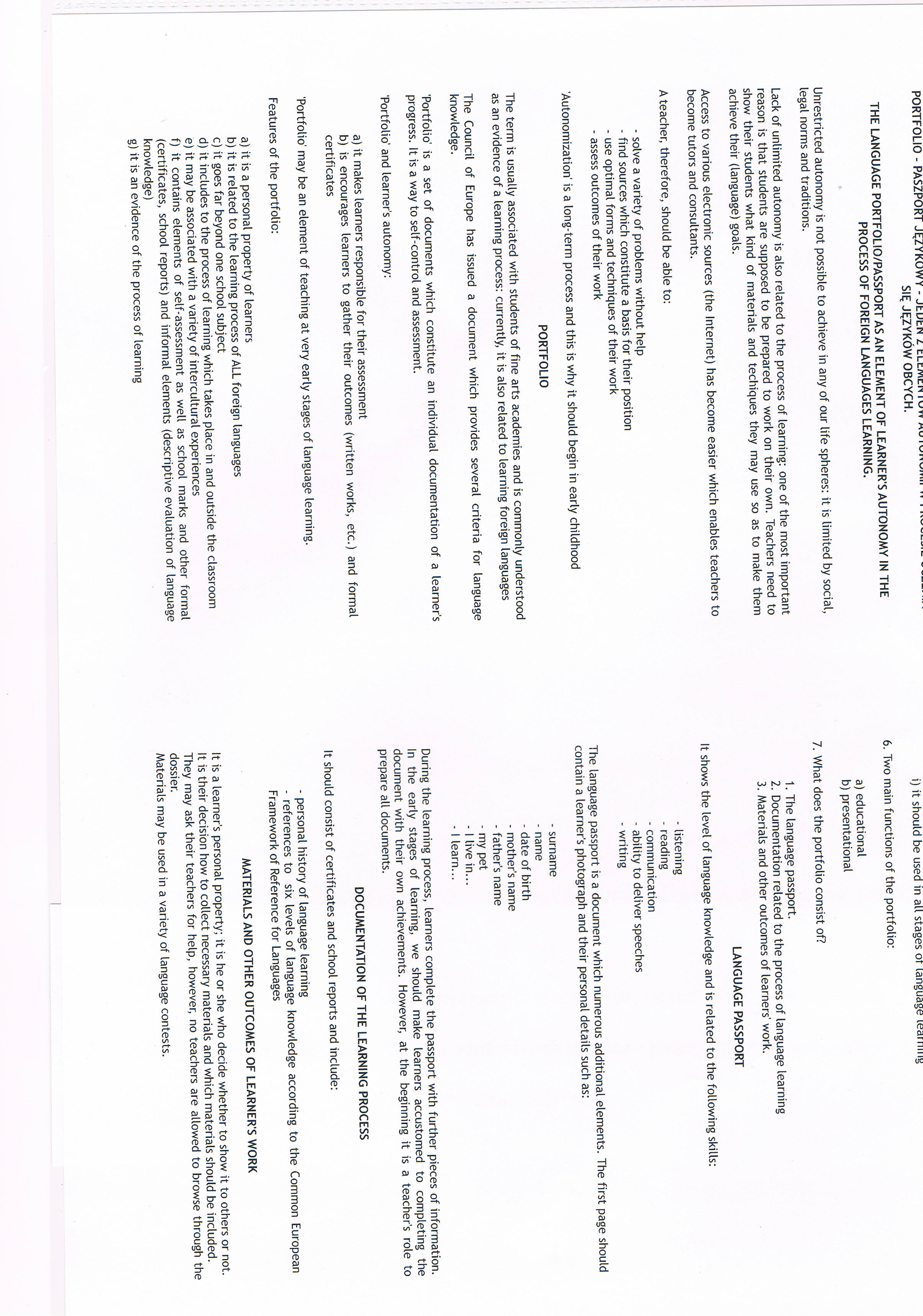CCF20110611�051

PORTFOLIO - PASZPORT JĘZYKOWY - JtutiN l tLcmcn iuit
SIĘ JĘZYKÓW OBCYCH.
THE LANGUAGE PORTFOLIO/PASSPORT AS AN ELEMENT OF LEARNER'S AUTONOMY IN THE PROCESS OF FOREIGN LANGUAGES LEARNING.
Unrestricted autonomy is not possible to achieve in any of our lite spheres: it is limited by social, legał norms and traditions.
Lack of unlimited autonomy is also related to the process of learning: one of the most important reason is that students are supposed to be prepared to work on their own. Teachers need to show their students what kind of materials and techiques they may use so as to make them achieve their (language) goals.
Access to various electronic sources (the Internet) has become easier which enables teachers to become tutors and consultants.
A teacher, therefore, should be able to:
- solve a variety of problems without help
- find sources which constitute a basis for their position
- use optimal forms and techniques of their work
- assess outcomes of their work
Autonomization' is a long-term process and this is why it should begin in early childhood
PORTFOLIO
The term is usually associated with students of fine arts academies and is commonly understood as an evidence of a learning process: currently, it is also related to learning foreign languages
The Council of Europę has issued a document which provides several criteria for language knowledge.
'Portfolio' is a set of documents which constitute an individual documentation of a learner's progress. It is a way to self-control and assessment.
'Portfolio' and learner's autonomy:
a) it makes learners responsible for their assessment
b) is encourages learners to gather their outcomes (written works, etc.) and formal certificates
'Portfolio' may be an element of teaching at very early stages of language learning.
Features of the portfolio:
a) it is a personal property of learners
b) it is related to the learning process of ALL foreign languages
c) it goes far beyond one school subject
d) it includes to the process of learning which takes place in and outside the classroom
e) it may be associated with a variety of intercultural experiences
f) it contains elements of self-assessment as well as school marks and other formal (certificates, school reports) and informal elements (descriptive evaluation of language knowledge)
g) it is an eyidence of the process of learning i) it should be used in all stages or language teamuig
6. Two main functions of the portfolio:
a) educational
b) presentational
7. What does the portfolio consist of?
1. The language passport.
2. Documentation related to the process of language learning
3. Materials and other outcomes of learners' work.
LANGUAGE PASSPORT
It shows the level of language knowledge and is related to the following skills:
- listening
- reading
- communication
- ability to deliver speeches
- writing
The language passport is a document which numerous additional elements. The first page should contain a learner's photograph and their personal details such as:
- surname
- name
- datę of birth
- mother's name
- father's name
- my pet
-1 live in...
- I learn...
During the learning process, learners complete the passport with further pieces of information. In the early stages of learning, we should make learners accustomed to completing the document with their own achievements. However, at the beginning it is a teacher's role to prepare all documents.
DOCUMENTATION OF THE LEARNING PROCESS
It should consist of certificates and school reports and include:
- personal history of language learning
- references to six levels of language knowledge according to the Common European Framework of Reference for Languages
MATERIALS AND OTHER OUTCOMES OF LEARNER'S WORK
It is a learneris personal property; it is he or she who decide whether to show it to others or not. It is their decision how to collect necessary materials and which materials should be included. They may ask their teachers for help, however, no teachers are allowed to browse through the dossier.
Materials may be used in a variety of language contests.
Wyszukiwarka
Podobne podstrony:
CCF20110611�051 PORTFOLIO - PASZPORT JĘZYKOWY - JŁUŁN l tLtmcii n->»» SIĘ JĘZYKÓW OBCYCH.THE LANG
Europa poliglotów Studium Języków Obcych, podobnie jak wszystkie inne jednostki Uczelni, przygotowuj
CCF20100108�028 4-1 Alina Nowicka-Jc/owa indywidualna przejawia się w wielości kształtów, przybieran
CCF20100526�002 Wpływ rzeźby terenu na pokrywę glebowąKSZTAŁTOWANIE SIĘ POKRYWY GLEBOWEJ W skali glo
CCF20101012�004 5 Rezystory dodatkowe wewnętrzne i boczniki wewnętrzne, wykonuje się z drutów mangan
CCF20101012�009 10 10 ż. Na stanowisku laboratoryjnym znajduje się także równia pochyła o kacie na
CCF20101213�003 zaniu z całością kultury materialnej i duchowej ujawni się w pełni rola książki jako
CCF20120124�015 b) nie znajduje sic; w progu rentowności, c) zna
CCF20130224�001 Nasze życzenia (1), przypuszczenia (2) i uprzejme prośby (3) odnoszące się do teraźn
CCF20130413�001 1. CEL ĆWICZENIA Celem ćwiczenia jest zapoznanie się studentów z metodami pomiarów z
CCF20160516�001 Och, spójrz - jaki duży kleks! Zastanów się, co można z niego wyczarować przez dorys
CCF20100222�012 ■1] Tabela 3.6. Sposoby rozjrrz.eslr/.ciiiania się nasion Typ i obsiewania
CCF20100314�006 56 Zagadnienia poprawności leksykalno-semantycznej różniących się jednak formą, nace
więcej podobnych podstron